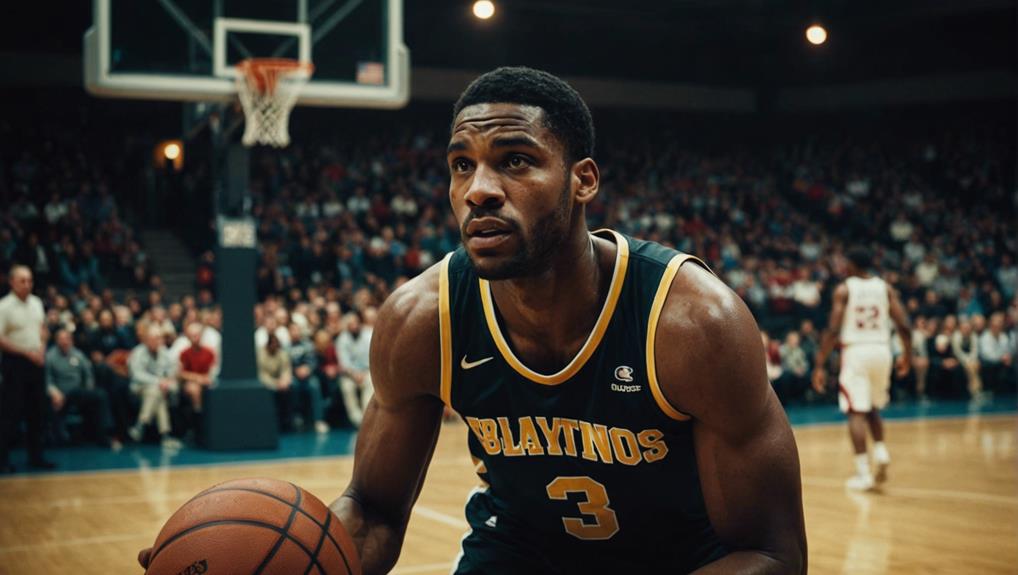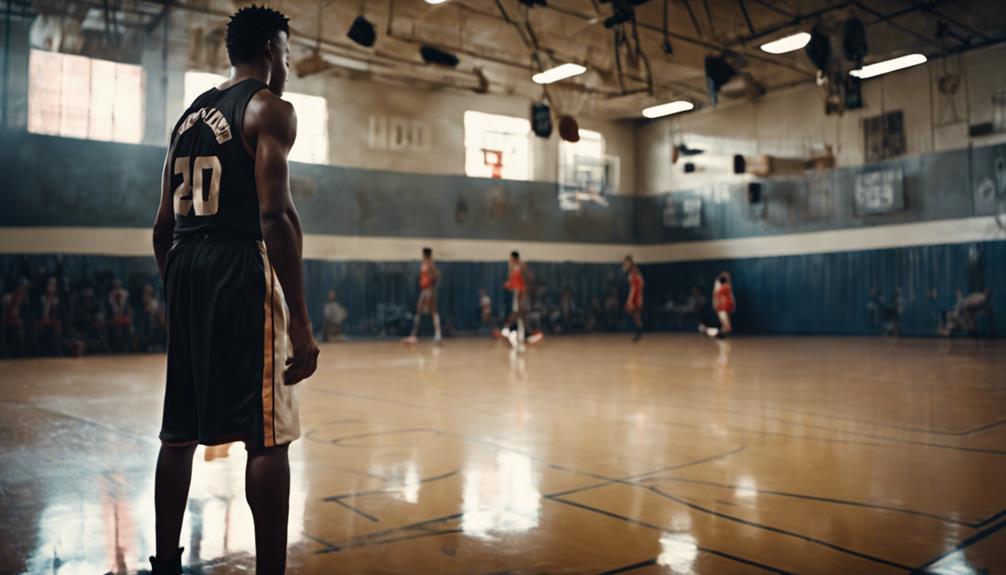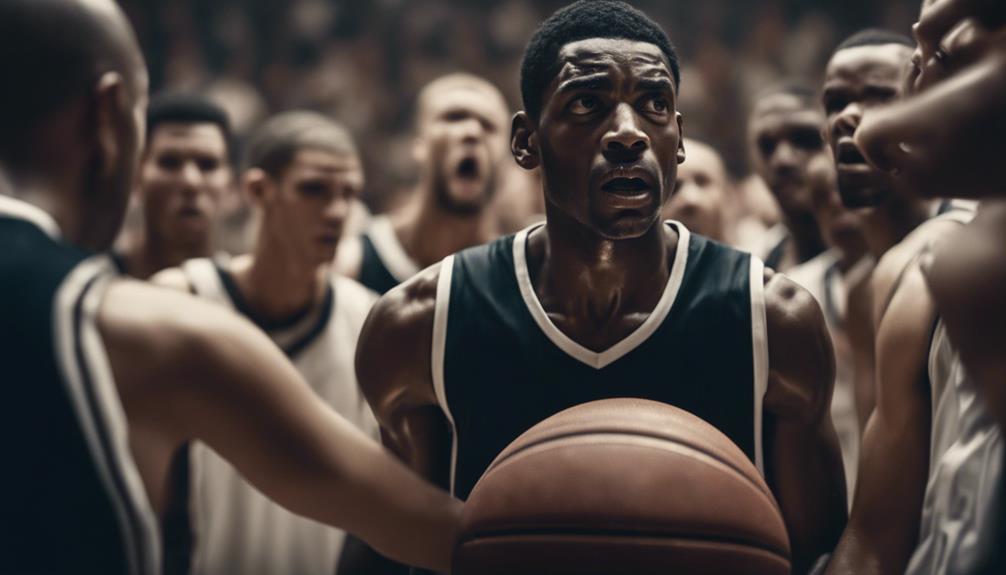
Obstacles for Black Athletes in Integrated Basketball
May 13, 2024In integrated basketball, Black athletes encounter hurdles due to historical discrimination, biases in talent evaluation, sparse representation in coaching, limited access to resources, stereotypes, and enduring racism. These obstacles shape their experiences on and off the court, making success an uphill battle.
Historical Roots of Discrimination in Basketball
Exploring the historical roots of discrimination in basketball reveals a troubling legacy of exclusion and inequality faced by Black athletes in the early 1900s.
The first Black athletes entering integrated basketball encountered a landscape marred by segregation and discrimination. Despite their talent, these players were met with unequal access to resources, limited opportunities for advancement, and discriminatory treatment both on and off the court.
In integrated basketball, Black athletes often found themselves overlooked for recognition, awards, and leadership roles that their white counterparts easily secured. The harsh reality of segregated leagues meant that Black players had to navigate a system designed to hinder their progress and success.
This historical context laid the foundation for the systemic barriers and prejudices that continue to affect Black athletes in basketball today, shaping their experiences and opportunities in the sport. The struggles faced by the first Black athletes in integrated basketball underscore the deep-seated challenges of overcoming discrimination and inequality within the sport.
Stereotypes and Biases in Talent Evaluation
You may have experienced your talent being overlooked simply because of your race, facing unconscious bias in scouting processes that hindered your opportunities.
Stereotypes about athleticism, intelligence, and leadership could have influenced how your skills were perceived, making it harder for you to showcase your abilities.
Overcoming these biases added an extra layer of complexity to your journey as a Black athlete in integrated basketball.
Talent Overlooked Based on Race
Black athletes in integrated basketball often found their exceptional talents overlooked due to stereotypes and biases in talent evaluation processes. Despite possessing outstanding abilities, many Black athletes faced unfair judgment and undervaluation in integrated basketball settings.
Racial prejudices greatly influenced how scouts and coaches assessed the talent and potential of Black athletes in the sport, creating obstacles for them to showcase their true capabilities. The systemic discrimination embedded in talent evaluation processes hindered opportunities for Black athletes to succeed in integrated basketball environments.
Overcoming these racial biases in talent evaluation posed a substantial challenge for Black athletes aiming to excel in the sport, highlighting the need for a more equitable and unbiased approach to evaluating talent in basketball.
Unconscious Bias in Scouting
Despite the undeniable talent possessed by Black athletes in integrated basketball, unconscious bias in scouting perpetuates stereotypes and biases in talent evaluation. Scouting reports may inadvertently contain subjective language that reinforces negative stereotypes about Black athletes, impacting their opportunities in the sport. Biases in talent evaluation can hinder the recognition of Black athletes' true potential, leading to missed opportunities for growth and advancement in integrated basketball programs. Overcoming unconscious bias in scouting is essential for promoting fairness and providing equal opportunities for Black athletes to showcase their skills and abilities on an equal playing field.
- Scouting reports may contain subjective language reinforcing negative stereotypes.
- Biases in talent evaluation can hinder recognition of Black athletes' potential.
- Overcoming unconscious bias is vital for promoting fairness in integrated basketball.
Stereotypes Affecting Player Opportunities
Stereotypes and biases in talent evaluation frequently result in Black athletes being overlooked or underestimated in integrated basketball. Historical influences have shaped perceptions of Black athletes' intelligence, work ethic, and skill level, leading to systemic barriers and discrimination. These stereotypes affect player opportunities, hindering Black athletes from receiving fair consideration for team selections and playing time.
Overcoming these biases is essential for ensuring equal opportunities and recognition in the sport. By addressing these ingrained prejudices, a more inclusive and fair environment can be fostered, allowing Black athletes to showcase their true abilities and contribute meaningfully to integrated basketball. It's imperative to challenge and dismantle these stereotypes to create a level playing field for all athletes.
Lack of Representation in Coaching and Leadership
Within integrated basketball programs, the lack of representation in coaching and leadership roles presents a significant hurdle for aspiring Black athletes. This underrepresentation is evident in the NBA, where only about 30% of head coaches are Black, highlighting the disparity in leadership positions. Limited opportunities for Black coaches further contribute to the challenge faced by Black athletes seeking coaching roles.
Despite excelling on the court, many Black athletes encounter difficulties moving into coaching or front office positions post-retirement. The absence of diverse leadership not only hampers the development and advancement of Black athletes but also restricts the visibility of role models who can inspire the next generation.
- Black athletes are often overlooked for coaching roles despite their experience and knowledge.
- The lack of representation in leadership positions perpetuates the cycle of underrepresentation for Black athletes.
- Opportunities for mentorship and guidance from Black coaching staff are limited, affecting the overall growth and support system available to Black athletes.
Challenges in Access to Resources and Opportunities

Access to resources and opportunities for Black athletes in integrated basketball remains a persistent challenge, impacting their development and success in the sport. Black athletes often face unequal access to essential resources like quality coaching, training facilities, and financial support, putting them at a disadvantage compared to their counterparts.
The limited opportunities for exposure and recruitment further hinder the progress of many talented Black athletes, limiting their chances to showcase their skills and advance in their careers. Discriminatory practices in hiring and promotion within basketball organizations create additional barriers for Black athletes aspiring to coaching and administrative roles.
Systemic biases present in scouting and player development programs disproportionately affect the growth and success of Black athletes, perpetuating existing inequalities. The lack of representation and support for Black athletes in leadership positions within basketball institutions also contributes to the ongoing obstacles they face in their career progression.
Pressures and Expectations on Black Athletes
Managing the pressures and expectations placed on Black athletes in integrated basketball requires resilience and determination in the face of heightened scrutiny and unfair comparisons. Black athletes often find themselves under intense scrutiny, facing unfair comparisons to their white counterparts.
The following points shed light on the challenges faced by Black athletes in addressing the pressures and expectations in integrated basketball:
- Stereotypes: Black athletes must constantly battle against stereotypes that suggest they're only valuable for their physical abilities rather than their skills and intelligence on the court.
- Racial Biases: The presence of racial biases can lead to Black athletes being judged more harshly or overlooked for opportunities, adding to the weight of expectations they carry.
- Systemic Racism: The systemic barriers in place can hinder the progress of Black athletes, making it even more challenging for them to meet the lofty expectations set before them.
Microaggressions and Racism on the Court

Getting around the basketball court as a Black athlete in integrated settings often means encountering microaggressions and racism that can undermine your performance and mental resilience. Opposing players and fans may hurl racial slurs and discriminatory remarks, creating a hostile environment where biased officiating, unfair calls, and targeted physical play are used to intimidate you. These subtle acts of racism can overshadow your skills and make the court a battleground for racial tensions.
Managing these challenges adds pressure and stress, requiring you to demonstrate resilience and mental strength. Overcoming microaggressions and racism on the court is essential for competing at the highest levels in integrated basketball. By staying focused on your performance despite the discriminatory circumstances, you can show your determination and skill in the face of adversity.
Intersectionality of Race and Gender in Basketball
As a Black female basketball player, you encounter a unique set of challenges due to the intersection of race and gender in the sport. These intersecting dynamics can lead to disparities in recognition, pay, and opportunities compared to your white counterparts.
Maneuvering through stereotypes, biases, and systemic barriers, you work hard to overcome the obstacles that hinder your success in integrated basketball.
Race and Gender Dynamics
How do race and gender intersect to create unique challenges for Black female athletes in integrated basketball? The intersectionality of race and gender in basketball poses significant hurdles for Black women, impacting their experiences on and off the court.
Here are a few key dynamics worth examining:
- Stereotypes: Black female athletes often face harmful stereotypes that can undermine their abilities and potential.
- Bias: The presence of bias in the basketball community can lead to unequal treatment and opportunities for Black women.
- Representation: Limited representation of Black female athletes in the sport contributes to feelings of isolation and a lack of support.
Addressing these dynamics is essential for promoting equity and inclusivity in integrated basketball.
Challenges Faced Together
Addressing the intertwined challenges of race and gender in integrated basketball requires acknowledging and dismantling the barriers that Black female athletes face daily. From the early struggles of the first Black players in the NBA to the ongoing experiences of African American women in the sport, the intersectionality of racial integration poses unique challenges.
Discrimination against Black female athletes in basketball includes facing stereotypes, limited opportunities, and unequal recognition compared to their counterparts. The intersectionality of race and gender compounds these obstacles, requiring Black women to work harder to prove themselves and overcome systemic barriers.
Overcoming these challenges necessitates a concerted effort to address both racial and gender biases, creating a more inclusive and equitable playing field for all athletes.
Conclusion
You've seen how obstacles for black athletes in integrated basketball stem from historical discrimination, stereotypes, and lack of representation. Despite their talent and hard work, black athletes face challenges in accessing resources, dealing with pressures, and facing racism on the court.
Did you know that only 23% of head coaches in Division I men's basketball are black, highlighting the lack of diversity in coaching leadership roles? This statistic underscores the need for greater representation and opportunities for black athletes in basketball.


